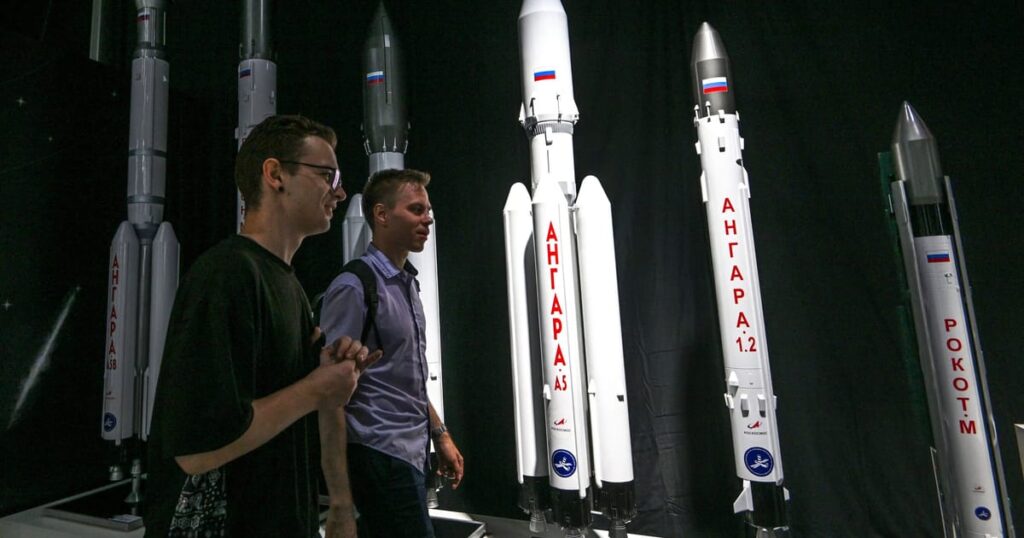 |
Despite war and sanctions, Vladimir Putin is trying to haul Russia back into the space race.
In the early hours of Friday morning, state space agency Roscosmos is poised to launch the country’s first lunar mission in nearly half a century as an ambitious play in the scramble to build a base on the moon.
“If they pull it off, it will be a massive technological and scientific achievement,” said Tim Marshall, author of “The Future of Geography” on the geopolitics of space. He argues a successful Russian landing, and fruitful year of research, would mark a big step forward in plans to build a moon base with China by the 2030s.
Russia’s Luna-25 mission is being dispatched to scope out the lunar south pole, where scientists believe there’s a plentiful supply of water locked in ice in the perpetual shade of mountain ridges. Firming up water reserves is a critical requirement for supporting life on the moon with breathable oxygen, drinking water and even rocket fuel, which would then help space-faring nations further explore the cosmos from any lunar outpost in the future.
“The first goal is to find the water, to confirm that it is there, … to study its abundance,” said Olga Zakutnyaya, from the Space Research Institute at the Russian Academy of Sciences in Moscow, of Luna-25’s main aim.
But simply successfully landing a spacecraft on the rocky lunar south pole — which would be a first in itself — would also prove to Beijing that Moscow still has something to offer when it comes to cutting-edge aerospace technology. The two countries have already pledged to work together to build a moon base by the 2030s, but Beijing is the clear leader these days.
“Putin knows that Russia is the junior partner in the China relationship, including in the space relationship,” said Marshall, arguing that the Luna-25 mission could help rebalance the scales.
On the other side of the geopolitical divide, the United States is planning to send astronauts to the south pole later this decade as part of its Artemis program supported by Canada and European countries.
And, despite the competition, NASA doesn’t seem worried about Moscow’s mission.
“I don’t think that a lot of people at this point would say that Russia is actually ready to be landing cosmonauts on the moon in the timeframe that we’re talking about,” NASA Administrator Bill Nelson said during a panel on Tuesday in response to Luna-25.
Pole race
Only three countries — the United States, China and the Soviet Union — have successfully landed spacecraft on the moon, and only the Americans have put boots on the lunar surface.
The likes of India, Japan and Israel have all tried and failed of late. In 2019, India’s Chandrayaan-2 mission crashed, while an earlier attempt by Israeli firms with Beresheet also failed that year. In April, Japanese start-up ipsace also saw its Hakuto-R Mission 1 crash.
Trying again, India’s Chandrayaan-3 mission, which literally translates as “moon vehicle” in Sanskrit, is scheduled to reach the surface on August 23 to explore the south pole, around the same time that Luna-25 is planning to attempt to land nearby.
“The fact that both Russia and India are targeting to land in the same, albeit large, region of the moon highlights that certain areas are more valuable than others,” said Benjamin Silverstein, an analyst for the Carnegie Space Project at the Carnegie Endowment for International Peace.
While Roscosmos insists there’s no chance of collision, a lack of agreed regulations for who can do what on celestial bodies like the moon means countries are deciding their own rules of the road when planning missions.
First landers on the lunar south pole could work up their own preferred standards and expect newcomers to follow their lead rather than relying on the slow and laborious process of trying to fix agreed lunar governance norms, Silverstein said.
The U.S.-backed Artemis accords sets out Washington’s preferred principles for a fresh era of space exploration, and would controversially allow countries to claim exclusive access to certain commercial zones around, for example, a moon base next to icy or resource-rich deposits.
“The growth [of Artemis signatories] to 29 shows that without question it’s going to be the dominant space bloc of the century, but for the foreseeable future they will never get China, Russia or their allies on board,” said Marshall.
Even without the politics, landing a spacecraft on the mountainous terrain of the moon’s dark poles isn’t easy.
“The south pole has a lot of craters and is very rocky,” said Nico Dettmann, the European Space Agency’s lead on lunar exploration, adding that a target accuracy of within 100 to 200 meters is required to be certain of a soft landing.
Current thruster and mapping technology, such as that deployed on Luna-25, will only be able to home in on a location between 15 and 30 kilometers from the target point, he said. “These space technology developments take time.”
Luna-25 had been set to include demonstrator navigation camera systems from the ESA as part of a cooperation deal, but that’s been scrapped due to Russia’s invasion of Ukraine, along with a separate mission to Mars dubbed ExoMars.

